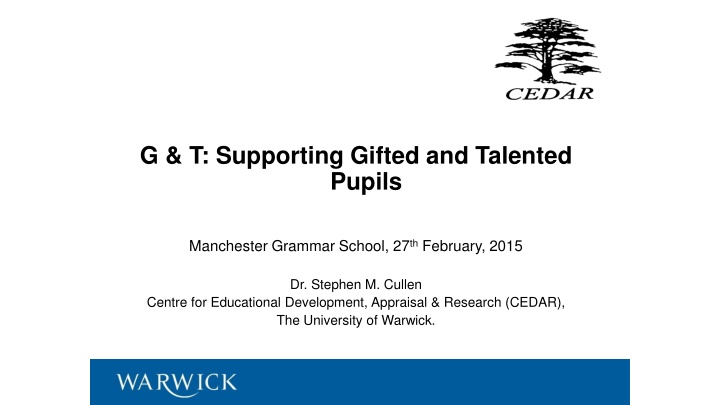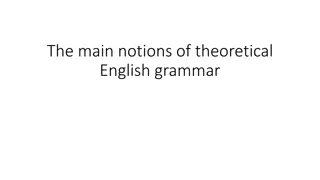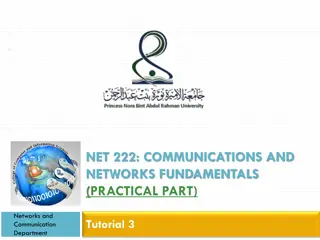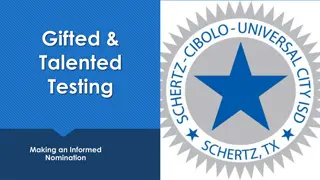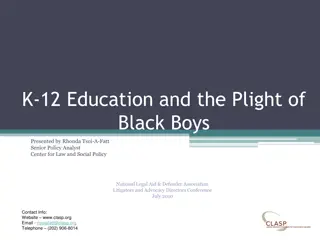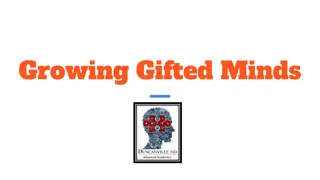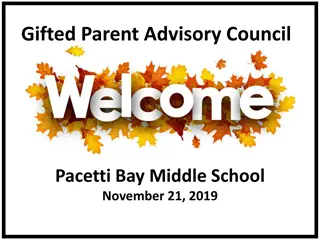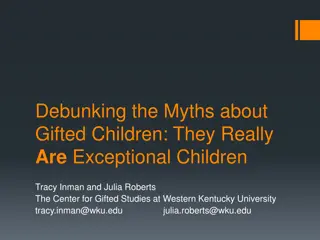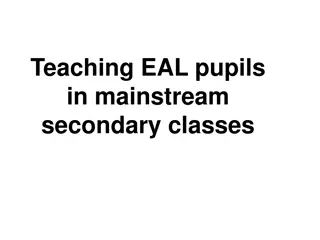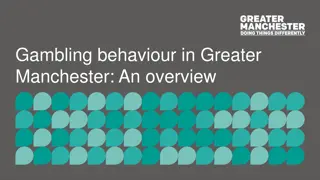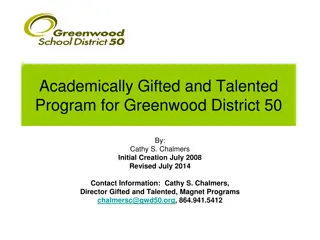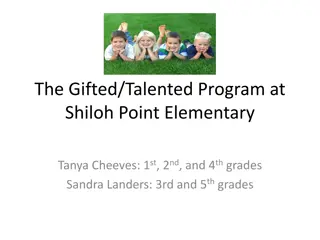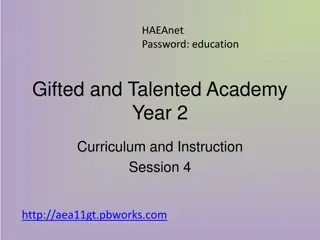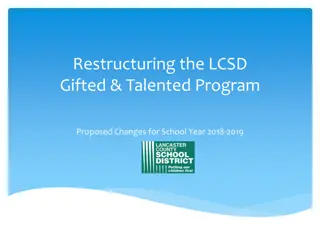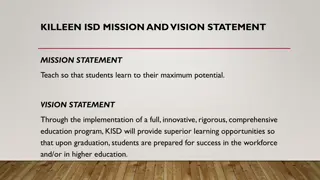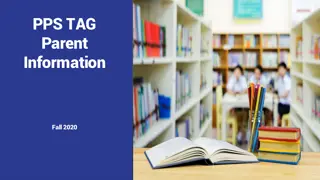Supporting Gifted and Talented Pupils at Manchester Grammar School
CEDAR at the University of Warwick focuses on educational and psychological issues, bridging policy and practice. Learn about G&T provision, research projects, and Warwick's history with gifted youth programs. Discover the evolution of G&T education in England, from the 1944 Education Act to current initiatives.
Download Presentation

Please find below an Image/Link to download the presentation.
The content on the website is provided AS IS for your information and personal use only. It may not be sold, licensed, or shared on other websites without obtaining consent from the author.If you encounter any issues during the download, it is possible that the publisher has removed the file from their server.
You are allowed to download the files provided on this website for personal or commercial use, subject to the condition that they are used lawfully. All files are the property of their respective owners.
The content on the website is provided AS IS for your information and personal use only. It may not be sold, licensed, or shared on other websites without obtaining consent from the author.
E N D
Presentation Transcript
G & T: Supporting Gifted and Talented Pupils Manchester Grammar School, 27thFebruary, 2015 Dr. Stephen M. Cullen Centre for Educational Development, Appraisal & Research (CEDAR), The University of Warwick.
Today CEDAR, University of Warwick, and G&T Background to G&T Who are the G&T? G&T provision: people, approach, activities, & structures Resources for G&T provision Questions
About CEDAR Research base at the University of Warwick. CEDAR founded in 1992; has particular interests in a range of educational and psychological issues. These typically focus on the interface between policy and practice and include research into new government initiatives across the age range of pre-school to higher education and continuing professional practice. We also specialise in researching special educational needs/inclusion, and parenting, families & early intervention.
University of Warwick and G&T The University of Warwick has a long & continuing association with G&T provision for school students. The National Academy for Gifted & Talented Youth (NAGTY) was founded at Warwick in 2002 as a DfES funded initiative. The university did not bid for NAGTY to continue after 2007. NAGTY was replaced by Warwick with its own centre, the International Gateway for Gifted Youth (IGGY) (2008-date). In October 2012, IGGY became an international network for gifted young people. Warwick s G&T work continues, with, for example, its national outreach programme for 14-18 year olds, Unitracks : http://www2.warwick.ac.uk/study/outreach/programmes/unitracks
CEDAR & G&T evaluation CEDAR heavily involved in providing the DfES with independent evaluations of NAGTY projects: Residential university summer schools (Warwick, York, Lancaster, Imperial, Durham, Bristol, Leeds, CCC Canterbury) Enhanced ITT PGCE Plus in maths and science Short, weekend university courses National competitions GOAL, GEP, Big Deal. These opportunities took young people beyond the national curriculum, both in terms of subjects and content.
G&T : (recent) origins in England Could argue that the 1944 Education Act was early G&T, in relation to grammar schools. Assisted Places Scheme, 1980-1997. In 1997, 35,000 pupils in 355 schools. Assisted Places ended in 1997, and Gifted & Talented became one of The National Strategies (1997-2011). But now .?
G&T now Governments, the education department, embedding & sustainability . (or not) http://www.bbc.co.uk/news/education-30279230 http://www.bbc.co.uk/news/education-31005170 http://www.independent.co.uk/news/education/education- news/gifted-pupils-from-deprived-areas-to-attend-regular- seminars-at-top-universities-9896616.html
G&T Who are the G&T? it would be fair to say that a definitive answer of the question, Who are the highly able? has not emerged. (House of Commons Inquiry into Highly Able Children, 1999, para 7). There are perhaps 100 definitions of giftedness around (Hany, 1993). High intelligence, measured by IQ? Top 5% in one or more subjects? Top 5-10% in one or more?
Identifying G&T in school Teacher identification: Nomination; subject specific criteria; checklists or rating scales. National tests/assessments: KS2, KS3, GCSE. Reasoning tests: Group Tests: e.g., CAT, MidYIS. Individual tests: BAS, WISC. Or: Children who are achieving, or have the potential to achieve, at a level substantially beyond the rest of their peer group (DfES, G&T guidance for primary schools, 2006). .some anecdotal examples .
https://www.youtube. com/watch?v=u1MKU JN7vUk Bees and the La Nouvelle Vague The Bee Keeper and The SPS candidate.
Supporting the G&T: An English model ? The English model: an integrated approach to G&T education (an integral part of daily provision; personalised learning) Core provision in school every teacher a teacher of the G&T Additional provision from external support. This model contrasts with, for example, the US model, typified by the John Hopkins Center for Talented Youth http://cty.jhu.edu/ .
Supporting the G&T: people (i) Assigning responsibility: 1. Teaching staff and teaching techniques ( quality-first teaching ): Setting open-ended problems; with a low threshold but a high ceiling Asking open questions Using Socratic questioning Limiting teacher-focused lesson delivery Including topical and current material. But you know this it s good teaching
Supporting the G&T: people (ii) Assigning responsibility: 2. A G&T co-ordinator. Schools have SENCOs, they need GaTCOs To compile, maintain, update & revise a G&T register To liaise with departments To provide resources To research external opportunities and links To monitor progress of G&T pupils.
Supporting the G&T: people (iii) Leadership: For G&T provision to be effective, to be embedded & sustainable, the leadership has to be there. The message from the top has to be clear and consistent. The head teacher (and SMT) have to be the GaTCo s big stick , so that he/she can speak softly , and successfully. What it looks like without leadership: None of the staff are aware of G&T issues & there is no real provision ; It s low priority because G&T education is not linked to funding , I think some of the senior management don t think much of G&T, they think it elitist .
Supporting the G&T: approach Infinity and beyond ! or going off-piste The aim should be to provide free-ranging, open-ended opportunities for children. Challenging children, encouraging them to really explore, helping them to soar. Going beyond and outside the national curriculum. What it is NOT an example from PGCE Plus (2004-07) involving 6thForm science and The Metro newspaper. An e.g. of what it is: check understanding , or don t:
Supporting the G&T: in-school activities Subject clubs and societies: After school clubs, lunchtime clubs; facilitated by staff, but led by pupils. Hobby clubs and societies: Chess, puzzle clubs, gaming clubs, journalists club. National, subject-based events: E.g. maths challenge: http://www.ukmt.org.uk/individual- competitions/intermediate-challenge/ 1stStory : http://www.firststory.org.uk/2014/09/24/first-story- national-writing-competition/
Supporting the G&T: structures (i) If your school GaTCO (and G&T provision) is to survive and thrive in your school, then external buttressing structures are necessary. Links and networks: Local universities. Universities accepted that part of the quid pro quo for the 9k fee was that they would take widening participation (WP) seriously. Approach local universities, contact the outreach & WP offices, find out how they can help make links with pupils in your school. /
Supporting the G&T: structures (ii) Ensure that all departments are members of relevant societies, e.g., The Historical Association http://www.history.org.uk/ The HA provides support, publications, local and national events, CPD, and resources. An example of its provision of a local, accessible resource here in Manchester: http://www.history.org.uk/resources/he_resource_1208_17.html
Supporting the G&T: structures (iii) Links and networks: The G&T charity, the National Association for Gifted Children: http://www.potentialplusuk.org/index.php Warwick s IGGY: https://www.iggy.net/ The Brightside Trust s career-focused support, with well developed mentoring system: http://www.thebrightsidetrust.org/ Summer schools: http://www.etoncollege.com/USS.aspx
Resources The links provided here represent a starting point for GaTCOs (the presentation will be e-mailed to all). A useful document that also needs to be mentioned is, Effective Provision for Gifted & Talented Students in Secondary Education (DCSF, 2007): http://webarchive.nationalarchives.gov.uk/20130401151715/htt p://www.education.gov.uk/publications/eOrderingDownload/DC SF-00830-2007.pdf And a forthcoming is, Educating the More Able Student What Works and Why, Martin Stephen & Ian Warwick (SAGE, April 2015).
